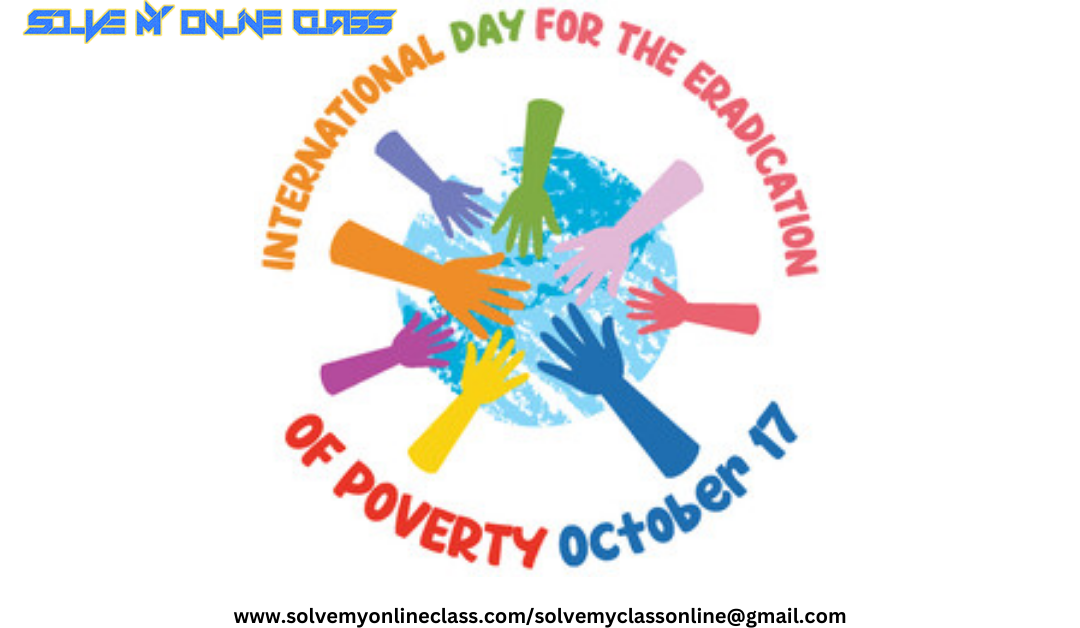People from all around the world gather to commemorate the International Day for the Eradication of Poverty on October 17th of each year. This day is a potent reminder of the continuous fight against poverty and the necessity of group initiatives to end it. Millions of people and communities around the world are still impacted by the persistent and complicated problem of poverty. We will discuss the importance of this day, the difficulties in ending poverty, and the steps that must be taken in order to truly change things in this blog.
Recognizing Poverty
Fundamentally, poverty is the lack of chances and basic resources required to lead a respectable life. It includes more than just a lack of money; it also includes not having access to clean water, healthy food, proper shelter, healthcare, education, and other necessities. Poverty is a complex and multidimensional issue since it is frequently entwined with vulnerability, discrimination, and social exclusion.
The Function of the UN
In 1992, the United Nations formally recognized the International Day for the Eradication of Poverty, demonstrating the dedication of the international community to tackling this urgent problem. The UN recognizes that everyone should be able to enjoy the fundamental rights and opportunities that lead to a decent life, regardless of their financial situation, and that poverty is a violation of human rights.
Every year, the International Day for the Eradication of Poverty emphasizes a different theme, but it always emphasizes the importance of taking action and having conversations to end poverty. The purpose of the day is to increase understanding, motivate action, and foster a sense of unity in the struggle against poverty.
Obstacles in the Campaign to End Poverty
It is an enormous objective to eradicate poverty, and there are a number of intricate issues that must be resolved:
- Economic Disparities: One of the biggest obstacles to the fight against poverty is still income disparity. The majority’s poverty may be prolonged and made worse by the concentration of wealth in the hands of a small number of people.
- Access to Education: Although education can be a very effective means of escaping poverty, a large number of adults and children around the world still do not have enough access to it. The cycle of poverty is sustained by this lack of access.
- Healthcare Disparities: Poor access to medical treatment and insufficient healthcare services can cause illness and even death, especially in underprivileged areas.
- Underemployment and unemployment: Families and individuals can become impoverished by working in low-paying occupations or without enough work prospects.
- Social Stigma and Discrimination: People’s access to opportunities such as work, education, and other resources is frequently impeded by discrimination based on race, gender, ethnicity, and other variables.
- Climate Change: Vulnerable and disadvantaged groups are disproportionately affected by climate change, which exacerbates their hardships and drives many of them from their homes.
- Absence of Basic Services: For disadvantaged communities, getting enough clean water, sanitary facilities, and wholesome food continues to be a major obstacle.
Taking Charge
Governments, communities, and people may all make significant progress in eliminating poverty even though there are many intricate and varied obstacles to overcome:
- Governments and non-governmental organizations (NGOs) can conduct programs aimed at alleviating poverty by offering financial transfers, food aid, and housing support to communities living in poverty.
- Education Initiatives: Encouraging and increasing access to high-quality education can help break the cycle of poverty by giving people the know-how and abilities they need to gain better opportunities.
- Healthcare Access: Improving the general well-being of underprivileged communities and lessening the effects of disease depend on providing affordable and easy access to healthcare services.
- Employment possibilities: Businesses and governments can collaborate to give marginalized groups access to vocational training and employment possibilities.
- Social Inclusion and Equality: It’s critical to advance equality and combat discrimination. Addressing concerns pertaining to gender, race, and ethnicity is part of this.
- Climate Action: Preserving the means of subsistence for marginalized people requires both mitigating and adapting to the effects of climate change.
- Community Involvement: By coordinating grassroots projects and speaking out for their needs, local communities may make a big difference in the fight against poverty.
In Conclusion:
The International Day for the Eradication of Poverty serves as a global call to action, serving as a reminder that poverty is a burden that requires our combined dedication and efforts to overcome. Despite the significant challenges, advancement is achievable with committed and well-coordinated efforts at all societal levels. Through tackling the underlying factors that lead to poverty, encouraging economic and social integration, and supporting laws that shield the most susceptible, we may strive towards a future in which poverty is eradicated. On this day, let’s keep in mind that millions of people actually live in poverty, and that it is our moral duty to eradicate it. Poverty is not just a number.






